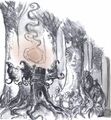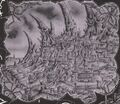Outlands

"Oh, I know that I don't need a whole lot of anything, I just want a little bit of everything na na na na."
- – Keith Urban
The Outlands (known in pre-Planescape times as Concordant Opposition, with both names later being combined into The Concordant Domain of the Outlands) is the True Neutral plane in the D&D Great Wheel Cosmology.
Exactly where it lies in relation to the other afterlives varies from edition to edition, since its ideal location, where the Great Wheel's metaphorical spoke would be, is also where the Inner Planes are. 1e had it resting "under" the inner planes and used the analogy of an outer plane mug containing some Astral Plane hot chocolate with an Inner Planes Marshmallow floating in it. 2e, the edition that actually brought us Planescape, abandoned that notion because TSR thought "Great Wheel" sounded better than "Great Mug," but forgot to actually clarify the location of the Outlands. 5e went with this idea: if you think of the Outer Planes as a ring of bricks, then the Outlands is the mortar between them.
It manages to connect to all Outer Planes simultaneously, making it one of the most cosmopolitan places in existence.
Because of the wide variety of inhabitants and traits, the Outlands is not the plane of Stupid Neutral (although a violently neutral race called the Rilmani have their realm within the plane.) Rather, the plane serves as a somewhat of a sliding scale of alignment, that gets more or less prominent depending upon your relative position, making it neutral by dint of it being not quite any other alignment either. To quote the 5e DMG, "One can ride a horse in the Outlands from a heaven to a hell."
This is a common theme of the Outlands: As a plane it serves to be the destination for those souls who were not quite the right alignment to get into the afterlife of their respective alignment (in addition to the actual True Neutral, of course), so they end up here. Although many deities and mortals choose to make their homes here, because of this, the plane is generally quite agreeable to all sorts of folks.
Because of the Outlands' favourable position as the "center" point of the cosmos and the meeting point of alignments, the Outlands serves as an ideal crossing point for interplanar travel, trade or negotiation.
Geography and Traits[edit]

First, the most noticeable thing about the Outlands is the Spire, which is a needle-like mountain that juts up into the sky. It can be seen from all points in the plane and makes for a great landmark as an indication of your direction. On the top of the spire can be seen the floating ring which is the city of Sigil. The odd thing is that the Spire is infinitely tall, despite the fact that you can see both ends of it, so don't bother trying to climb it. Although mischievous locals get a kick out of encouraging clueless strangers to try and attempt it.
The Outlands has no layers like other planes do (Sigil isn't counted as a layer), it is simply a land mass of theoretically infinite area. That's because it has some absolutely mind-bending geometry and magical inhibitions that no-one can make sense of, but people accept as being part of the nature of the plane, and nearly everything has to do with the Spire.
Distance on the plane is entirely subjective depending upon your direction of travel: The further outwards one moves from the spire the more that distance compresses itself. It actually gets to the point where the land outward from the Gate Towns, called the Hinterlands, operates in an especially notable way. If you start at a Gate Town and travel outwards, then no matter how far you traveled, if you turn around and travel back, you will find that not only had you never traveled more than 320 miles from the town in the first place, but that the terrain you covered will be as unfamiliar as if you had never traveled that way at all. Even creepier, old cities and abandoned settlements dot the Hinterlands, with any information on them lost to time. There are also tales of stranger still oddities in the Hinterlands, such as portals to unknown planes or even entirely new realities.
Another odd feature of the plane is its inhibition of magic and divine power. Starting at 1,100 miles from the Spire, magic starts to cease functioning. Standing in a Portal town, 9th Level spells don't work, and this only gets more severe the closer to the spire you get. When you stand at the base even the most powerful Gods find that they have no power.
It's for that reason that the wars between various alignments and races don't spill into the Outlands, despite its favourable location, those armies would just end up hamstringing themselves before they'd even begun.
Places of Interest[edit]
The Portal Towns represent the link to the outer edges of the wheel; they are evenly spaced in a roughly 1000 mile radius around the spire. Each outer plane has its own respective Portal Town positioned in the Outlands accordingly with its position on the wheel, so it is closest to its planar neighbors and situated furthest from its diametric opposite. The portals allow planar travel to and from the Outlands, so you're obviously most likely to find Archons in the portal town for Celestia or Slaad in the portal town for Limbo for example.
If the prevailing attitude and alignment of the town shifts too far from its neutral position, it drops out of the Outlands into the plane it was connected to (this is actually true of any afterlife plane, as the inhabitants of Arcadia can assure you, it's just that the Gate towns of the Outlands are particularly prone to this), its portal getting reassigned to a different town which then takes up its position in the ring around the Spire (the new town doesn't literally "move" into position, but just remember that terms like "distance" are flexible on the plane, and it is likely that the landscape rearranges itself to fill the void). Some within the various portal towns are extremely hostile to those that might hold them back from reaching the Outer Plane. Others seek to keep the town (and its merchants) securely moored in the Outlands by making sure there is some darkness in every light, and some light in every dark.
There are plenty of other "normal" towns on the Outlands, filled with Petitioners and Mortals of a variety of alignments and philosophies, but they typically prevail towards inoffensive neutrality and are relatively unremarkable places to visit. Though there are exceptions: the realms of the Gods located here can be as grand as anywhere else on the planes, and their inhabitants can be just as zealous.
Inhabitants[edit]
The Outlands is somewhat of an exception when it comes to Petitioners and it has a rather ecclectic mixture to choose from:
First, those souls who were "not quite" the right alignment to get into their respective afterlife end up here, as do those who were truly committed to neutrality. Those Petitioners return much as they did in life, their forms practically unchanged. However, the Outlands is one place where Petitioners from other planes can travel to, which is quite a significant development, as in most cases Petitioners cannot leave their home plane without dissolving into nothingness, since their makeup is entirely from the energies of that plane. So either the Outlands really is something special, or it isn't really its own plane at all and is merely where all other afterlives overlap. Beyond the Petitioners, you can find pretty much any form of Outsider here, from Guardinals to Yugoloth to Slaadi to Modrons if you know where to look.
The Native outsiders are called the Rilmani, who are generally more numerous the closer to the Spire you get, which is why there is no spell for summoning them. The Dabus of Sigil could be thought of as an additional, separate breed of outsider.
A Faction (capital "F") called the Athar also hold headquarters in the Outlands following the Faction War right at the base of the Spire, where they plot to oust the Gods as fraudsters and phonies not worth worshipping. Their camp at the base of the Spire protects them from divine retribution, but also puts them hundreds, if not thousands, of miles from anywhere remotely useful.
The Outlands is also the home front for the Concordant Killers, a group of very powerful beings who are part celestial, part infernal and are a bunch of divine hitmen dedicated to maintaining balance. They use swords that are somehow axiomatic, anarchic, holy and unholy at the same time, and use the full suite of Detect Alignment and Protection from Alignment.
Gallery[edit]
-
-
-
Torch
-
Bedlam
-
Ribcage
-
Xaos
-
Basically, each box on the outer edge of this image corresponds to one of the other D&D afterlives, and then everything in the middle (as well as everything that's halfway between any two other boxes) gets dumped here.






